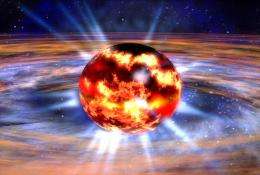June 10, 2013 report
Research team proposes lumpy crust of X-ray pulsars responsible for arrest of spin slowing

(Phys.org) —A trio of researchers working in Spain suggests in a paper published in the journal Nature Physics that the surface of some neutron stars might be "lumpy." Stars with such a surface might help explain, they say, the lack of pulsars with spin periods longer than 12 seconds. After running simulations in their lab, the researchers found that neutron stars with lumpy "pasta-like" surfaces would slow to a certain point then stop slowing with periods remaining constant at near to 12 seconds.
Scientists believe that neutron stars—the remnants of much larger stars that exploded—have crusts that are solid, made of atomic nuclei. Inside, they believe, are free neutrons in a liquid core. Energy from the explosion keeps them spinning. Some such neutron stars emit radiation from the poles and if those poles happen to line up with us here on Earth, they are seen as pulsating. As time passes, energy is radiated away from the star, slowing its spin. Some, however, appear to cease slowing when they get to a certain point, which happens to be at about 12 revolutions per second. The question that has puzzled researchers is, why?
In this new effort, the researchers ran computer simulations of the stars' motion over time. To try to cause some of them to stop slowing, they adjusted the parameters that describe the stars' crust. In so doing they found that those stars that had lumpy crusts slowed, just like the real things, down to around 12 revolutions per minute and then stayed steady for millions of years thereafter. Those stars with smooth crusts continued to slow their spin, reaching speeds as low as one revolution per hundred seconds.
The researchers note that their results are logical: a lumpy crust wouldn't be able to conduct electrical current as well as one that was smooth—it's the electrical current that keeps the stars' magnetic fields going. Lowering the magnetic field would mean less energy would be radiated into space, which means more energy would remain available to maintain a stable rotation speed.
As for why some neutron stars might have a lumpy surface, the researchers suggest it could be because the atomic nuclei is, for an unknown reason, packed tighter than with other neutron stars, resulting in a pasta-like surface.
More information: A highly resistive layer within the crust of X-ray pulsars limits their spin periods, Nature Physics (2013) doi:10.1038/nphys2640
Abstract
The lack of isolated X-ray pulsars with spin periods longer than 12 s raises the question of where the population of evolved high-magnetic-field neutron stars has gone. Unlike canonical radiopulsars, X-ray pulsars are not subject to physical limits to the emission mechanism nor observational biases against the detection of sources with longer periods. Here we show that a highly resistive layer in the innermost part of the crust of neutron stars naturally limits the spin period to a maximum value of about 10–20 s. This highly resistive layer is expected if the inner crust is amorphous and heterogeneous in nuclear charge, possibly owing to the existence of a nuclear 'pasta' phase. Our findings suggest that the maximum period of isolated X-ray pulsars may be the first observational evidence for an amorphous inner crust, whose properties can be further constrained by future X-ray timing missions combined with more detailed models.
Journal information: Nature Physics
© 2013 Phys.org





















